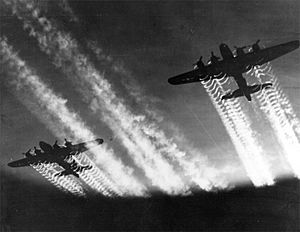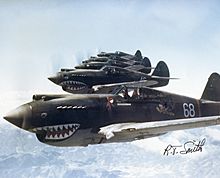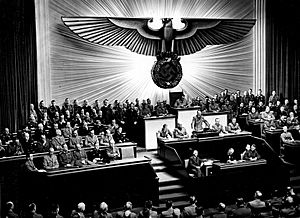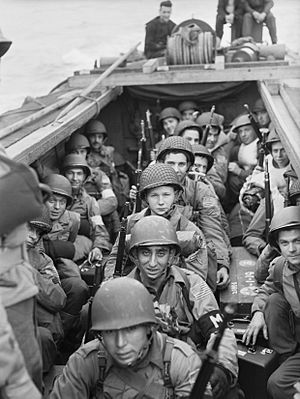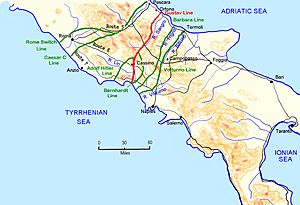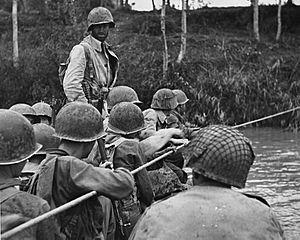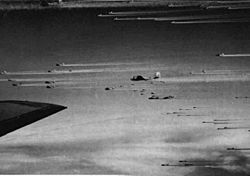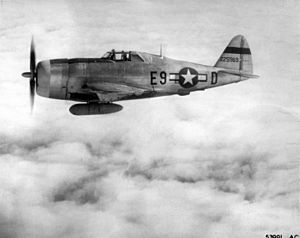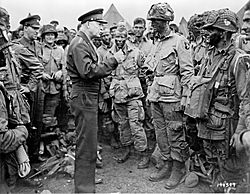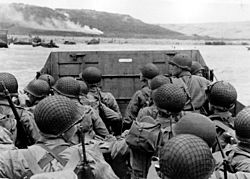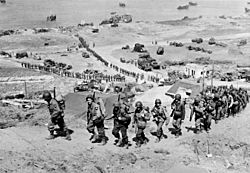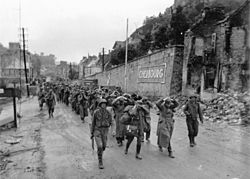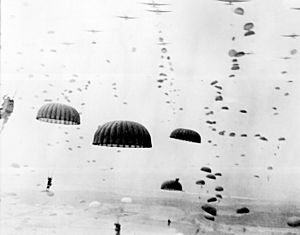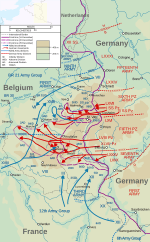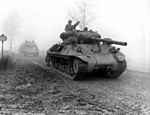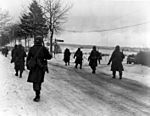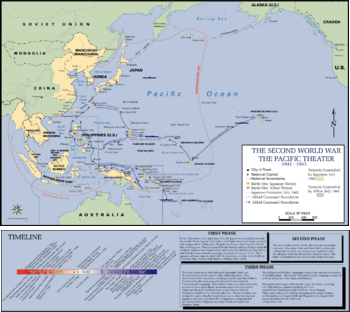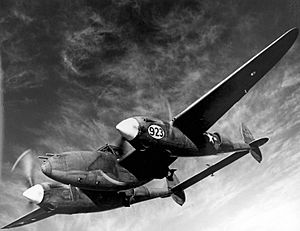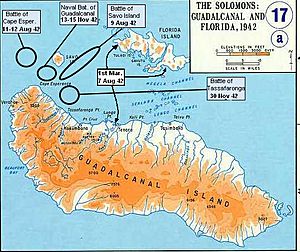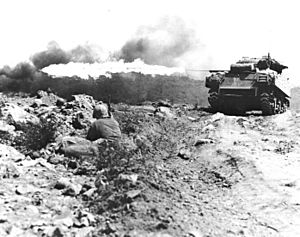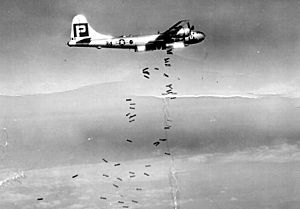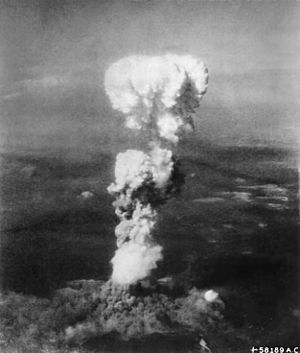Military history of the United States during World War II facts for kids
The military history of the United States in World War II tells the story of how the United States fought in World War II. This huge global conflict lasted from 1939 to 1945. The US joined the war after the attack on Pearl Harbor on December 7, 1941. Before this, the United States tried to stay neutral. However, it still helped countries like Britain, the Soviet Union, and China by sending them war supplies through the Lend-Lease program.
About 16 million Americans served in the US Armed Forces during the war. Over 400,000 were killed, and many more were wounded. Key leaders like President Franklin D. Roosevelt, General George Marshall (who led the Army), and Admiral Ernest King (who led the Navy) guided the US effort. The main goal was to defeat Germany in Europe first. But after Pearl Harbor, fighting Japan in the Pacific became very urgent.
In the Pacific, Admiral Chester W. Nimitz led the fight against Japan. The Japanese Navy initially had the upper hand, taking over places like the Philippines. But in June 1942, the US won a major victory at the Battle of Midway, sinking several Japanese aircraft carriers. After this, the US used an "island hopping" strategy. This meant capturing key islands one by one to get closer to Japan. General Douglas MacArthur led ground forces in the Pacific. Eventually, after heavy bombing and the capture of Okinawa, Japan surrendered following the atomic bombings of Hiroshima and Nagasaki.
In Europe, the US first sent aid to Britain and the Soviet Union. American forces then fought in the North African Campaign and later in Italy. The biggest invasion was D-Day in June 1944, led by General Dwight D. Eisenhower. US and British air forces bombed German cities and factories. Germany was attacked from all sides and surrendered in May 1945, after Adolf Hitler died.
Americans at home strongly supported the war. They provided soldiers, weapons, money, and high spirits. World War II was very expensive, costing the US billions of dollars.
Contents
- How the US Joined the War
- Lend-Lease and US Actions Before Pearl Harbor
- War in Europe and North Africa
- Europe First Strategy
- Battle of the Atlantic
- Operation Torch: Landing in North Africa
- Invading Italy
- Strategic Bombing of Germany
- Operation Overlord: D-Day and the Invasion of France
- Breaking Out: Operation Cobra
- German Counterattacks
- Operation Dragoon: Southern France
- Operation Market Garden
- Battle of the Bulge
- Invasion of Germany
- War in the Pacific
- Other US Military Efforts
- Attacks on US Soil
- Other Important Units and Services
- Timeline of Key Events
- See also
How the US Joined the War
American people generally disliked the Axis Powers, but there was debate about how much help to give the Allies. After World War I, the US tried to stay out of foreign conflicts. This was called isolationism. President Franklin D. Roosevelt wanted to be more involved, but Congress passed Neutrality Acts to keep the US out of wars.
By 1940, the US started becoming the "Arsenal of Democracy" for the Allies. This meant supplying money and war materials. For example, the US traded 50 old destroyers to Britain for the right to use British military bases. After France was quickly defeated by Germany in 1940, the US began to build up its own military. This included the first peacetime draft. When Germany invaded the Soviet Union in June 1941, the US also started sending Lend-Lease aid to them.
Americans were even more against Japan's actions in Asia. After Japan invaded Manchuria in 1931, the US refused to recognize any land taken by force. The US also stopped a trade agreement with Japan and placed a full embargo on them. This meant no more trade, especially for oil, which Japan needed for its military.
American Volunteers Before the War
Before the US officially entered World War II, some Americans volunteered to fight against the Axis powers. Even though it was against US law to join foreign armies, many changed their nationality to Canadian to do so.
One famous group was the Eagle Squadrons. These were RAF (British Air Force) squadrons made up of American volunteers. They flew against German planes during the Battle of Britain. In September 1942, these squadrons became part of the US Army Air Forces. They shot down many German planes.
Another well-known group was the Flying Tigers. This group of American pilots fought for the Chinese Air Force against Japan. They were led by Claire Lee Chennault. The Flying Tigers were very successful, destroying many enemy aircraft. They started their first combat mission just after the Pearl Harbor attack.
How the US Military Was Organized
In 1942, President Franklin D. Roosevelt created a new way to lead the US Armed Forces. He remained the Commander-in-Chief. Admiral Ernest J. King was in charge of the Navy and Marine Corps. General George Marshall led the Army and the Army Air Forces.
Roosevelt also formed the Joint Chiefs of Staff. This group made the big decisions about American military strategy. Admiral William D. Leahy was the chairman and Roosevelt's main military advisor. When dealing with Europe, the Joint Chiefs worked with their British partners to form the Combined Chiefs of Staff. Roosevelt usually listened to his military advisors. Civilians handled things like drafting soldiers and getting supplies, but they didn't decide on military strategy.
Lend-Lease and US Actions Before Pearl Harbor
The year 1940 was a turning point for the United States. Germany's victories in Europe made many Americans think that the US might need to get involved. In March 1941, the Lend-Lease program began. This program sent money, weapons, and food to Britain, China, and later the Soviet Union.
By 1941, the US was already taking an active part in the war, even though it was officially neutral. German submarines, called U-boats, were sinking many ships in the Atlantic. President Roosevelt extended the Pan-American Security Zone to protect supply lines. US Navy ships started escorting Allied convoys.
In July 1941, the US military occupied Iceland. This was to replace British forces there and protect important shipping routes. Up to 40,000 US troops were stationed in Iceland, which was a large number compared to Iceland's population.
American warships had several clashes with German U-boats. In September 1941, a U-boat attacked the destroyer USS Greer. A week later, Roosevelt ordered US warships to attack U-boats on sight. This meant the US Navy was effectively fighting a naval war against Germany in the Atlantic.
War in Europe and North Africa
On December 11, 1941, just three days after the US declared war on Japan, Adolf Hitler and Nazi Germany declared war on the United States. The US then declared war on Germany and Italy.
Europe First Strategy
The Allies had a main strategy: defeat Germany first, then focus on Japan. This was because Germany directly threatened major Allied capitals like London and Moscow. The US agreed with this "Europe first" plan. Even after the attack on Pearl Harbor, President Roosevelt and British Prime Minister Winston Churchill confirmed that Germany was the main enemy.
Battle of the Atlantic
The Battle of the Atlantic was the longest fight of World War II, lasting from 1939 to 1945. It was a battle between German U-boats and Allied ships carrying supplies. These supply convoys, mostly from North America, were vital for Britain and the Soviet Union. The US Navy joined the fight in September 1941, helping to protect these convoys.
Operation Torch: Landing in North Africa
The United States officially entered the war in the west with Operation Torch on November 8, 1942. This was an invasion of North Africa. General Dwight D. Eisenhower led this attack. American forces faced some challenges early on, especially at the Battle of the Kasserine Pass in February 1943. However, General George S. Patton took command, and the Allies eventually pushed back the Germans. By May 1943, Axis troops in North Africa surrendered.
Invading Italy
The next step for the Allies was to invade Europe through Italy. Operation Husky began on July 9, 1943, with a large amphibious landing in Sicily. This was the biggest landing of its kind at the time. American and British forces successfully captured the island by August.
After Sicily, Italy's dictator, Benito Mussolini, was removed from power. The Allies then landed on the Italian mainland in September 1943. Italy surrendered, but German troops quickly took over the defense. The fighting in Italy was very tough, with Germans building strong defensive lines. The Allies slowly pushed north, breaking through lines like the Volturno Line and the Bernhardt Line. They faced heavy resistance at places like Monte Cassino. Rome finally fell to the Allies in June 1944. The fighting in Italy continued until May 1945.
Strategic Bombing of Germany
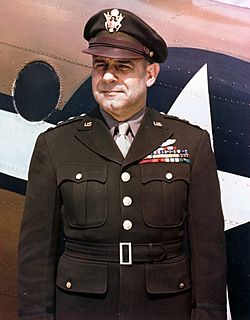
The United States Army Air Forces (USAAF) launched many bombing raids against Germany's factories and cities. They used large bombers like the B-17 and B-24. These raids were done during the day to be more accurate. At first, there weren't enough fighter planes to protect the bombers, so losses were high. The introduction of the P-51 Mustang fighter, which could fly long distances, helped reduce these losses.
The goal of the bombing was to destroy Germany's ability to make war supplies. While the US aimed for "precision bombing" of factories, many bombs also hit cities. For example, a single attack on Hamburg in 1943 killed about 50,000 civilians. The bombing forced Germany to use many resources to defend against air attacks.
In 1944, General Jimmy Doolittle changed the strategy for US fighters. Instead of staying close to the bombers, fighters were allowed to fly ahead and clear the skies of German planes. This helped the Allies gain control of the air over Europe. By April 1944, the Allies had achieved air superiority. The bombing campaigns caused massive damage to German industrial areas and cities.
Operation Overlord: D-Day and the Invasion of France
The second major front in Europe opened on June 6, 1944, with the invasion of Normandy. This was the largest amphibious assault in history. General Dwight D. Eisenhower was the Supreme Allied Commander.
Before the main landings, US Army Rangers climbed cliffs at Pointe du Hoc to destroy German guns. American paratroopers from the 82nd and 101st Airborne divisions also dropped behind enemy lines to protect the landings.
American troops landed on two beaches: 'Omaha' and 'Utah'. At Utah Beach, resistance was light. But at Omaha Beach, the Germans had strong defenses. American soldiers faced intense fire and suffered heavy losses. Despite this, small groups of soldiers fought their way inland, attacking German bunkers from behind. By the end of D-Day, the Americans had secured footholds, but with over 6,000 casualties at Omaha.
After securing the beaches, the Allies needed a deep-water port. American forces pushed towards Cherbourg at the end of the Cotentin Peninsula. They captured it by June 29, but the Germans had destroyed the port facilities.
Breaking Out: Operation Cobra
After D-Day, Allied forces were stuck in Normandy for a while, fighting in dense hedgerows. But Operation Cobra, launched on July 24, mostly by American troops, broke through the German lines. This allowed Allied armored divisions to sweep into France. This led to a major defeat for the Germans, with many soldiers trapped in the Falaise pocket. Paris was liberated on August 25.
German Counterattacks
The Germans tried to counterattack. Operation Lüttich in August 1944 was an attempt by Hitler to cut off American forces. However, Allied aircraft caused heavy losses to German tanks, and the attack failed. This also led to many German troops being trapped in the Falaise Pocket.
Operation Dragoon: Southern France
On August 15, 1944, the US 7th Army and other Allied forces landed in southern France. This was Operation Dragoon. Their goal was to secure southern France and capture Marseille for supplies. The operation was successful, forcing German forces to retreat.
Operation Market Garden
In September 1944, the Allies launched Operation Market Garden. This plan, led by British General Bernard Montgomery, aimed to capture several bridges in the Netherlands. The idea was to open a route across the Rhine River into Germany. American 82nd and 101st Airborne Divisions were dropped to capture bridges. However, the operation failed because the Allies couldn't capture the bridge at Arnhem. A strong German Panzer unit defended the town, and ground forces couldn't reach the paratroopers in time.
Battle of the Bulge
On December 16, 1944, the Germans launched a surprise attack in the Ardennes forest. This was the Battle of the Bulge. They hoped to split the Allied lines and capture the city of Antwerp. The attack created a large "bulge" in the Allied front.
The town of Bastogne became a key point. General Eisenhower ordered the 101st Airborne Division to defend it. The town was surrounded, and the defenders were low on supplies. When the Germans demanded surrender, General Anthony McAuliffe famously replied, "Nuts!" General Patton's army then turned north and broke through to Bastogne, ending the siege. The Battle of the Bulge was the largest and bloodiest battle fought by the United States in World War II, with about 89,000 American casualties.
Invasion of Germany
By early 1945, the Allies were winning in Europe. After the Battle of the Bulge, the Allies pushed towards the Rhine River. On March 7, they captured the last intact bridge across the Rhine at Remagen. This allowed them to cross into Germany. The Americans then trapped 300,000 Germans in the Ruhr Pocket.
American forces continued pushing east. In April, they met the Soviet Red Army at Torgau on the Elbe River. The Germans surrendered Berlin to the Soviets on May 2, 1945. The war in Europe officially ended on V-E Day, May 8, 1945.
War in the Pacific
The Attack on Pearl Harbor
Because Japan was expanding in Asia, the United States, Britain, and the Netherlands cut off all oil supplies to Japan. Japan needed this oil for its military. Japan decided that war with the US was unavoidable and chose to strike first.
On December 7, 1941, Japan launched a surprise attack on the US naval base at Pearl Harbor, Hawaii. Japanese planes attacked in two waves, destroying or damaging many battleships and aircraft. Over 2,400 Americans were killed. Japan's goal was to cripple the US Pacific Fleet. However, the attack failed to hit US aircraft carriers, which were out at sea. The "sneak attack" made Americans very angry and united the country for war against Japan.
The next day, December 8, 1941, President Roosevelt called it "a date which will live in infamy" and asked Congress to declare war on Japan. Congress quickly agreed.
Fall of the Philippines and Dutch East Indies
Within hours of Pearl Harbor, Japanese air forces attacked US bases in the Philippines. The Japanese army invaded, trapping American and Filipino forces. General Douglas MacArthur was ordered to leave, but he promised, "I shall return." Many prisoners died in the Bataan Death March and in harsh Japanese prison camps.
The Japanese Navy also captured the Dutch East Indies to get its rich oil resources. Allied forces tried to stop them but their fleets were quickly sunk.
Island Hopping Strategy
After the attack on Pearl Harbor, the US Navy was ready when Japan tried to destroy the American Pacific Fleet at Midway Island. American intelligence intercepted Japan's plan, allowing Admiral Chester W. Nimitz to set a trap. The Battle of Midway began on June 4, 1942. The US won a huge victory, sinking four Japanese aircraft carriers while losing only one of its own. This battle was the turning point in the Pacific War. The United States now had the advantage and went on the offensive.
After Midway, the US began its "island hopping" strategy. This meant capturing key islands that could support airfields, while bypassing heavily defended islands that weren't as important. Fighting for each island was very fierce.
Air Power in the Pacific
Air power was crucial in the Pacific. General George Kenney led tactical air power for General MacArthur. The US built many airfields on captured islands, often in difficult conditions. These airfields were vital for launching planes closer to Japan.
The arrival of better fighter planes, like the twin-tailed Lockheed P-38 Lightning, gave the Americans an advantage. US pilots also developed new tactics, like flying low to drop bombs that skipped across the water to hit ships.
Guadalcanal: First Major Offensive
The Guadalcanal Campaign, from August 1942 to February 1943, was the first major Allied offensive in the Pacific. American forces fought against determined Japanese resistance. Both sides faced huge supply problems. The Japanese supply system often failed, leading to many of their soldiers starving.
US Marines landed on August 7, 1942, and quickly captured Henderson Field. The Japanese launched many counterattacks, but the Americans held their ground. After six months of fighting, the island was under Allied control. This was a big American victory, showing that the US could keep up its forces better than Japan.
Tarawa: A Brutal Fight
The Battle of Tarawa in November 1943 showed how fiercely the Japanese would fight. American landings faced strong defenses, and many tanks were lost. After days of brutal fighting, the US took control of Tarawa. Out of 2,600 Japanese soldiers, only 17 were still alive. This battle made it clear that future island invasions would be very costly.
Liberating the Philippines
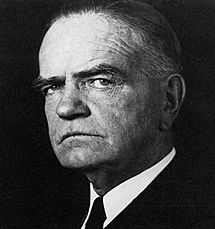
To prepare for retaking the Philippines, the US captured the Mariana and Palau Islands in 1944. These islands were important because they were close enough for new B-29 bombers to reach Japan.
General MacArthur kept his promise to return to the Philippines, landing at Leyte on October 20, 1944. The Battle of Leyte Gulf (October 1944) was a huge naval battle, arguably the largest in history. The US won a decisive victory, sinking almost all of Japan's remaining fleet. The fight to recapture the Philippines was long and hard, lasting into 1945.
Iwo Jima: Iconic Battle
The small island of Iwo Jima was needed for fighter escorts and emergency landings for B-29s. The Japanese had built many fortified positions, including bunkers and tunnels. The Marine attack began on February 19, 1945. The fighting was incredibly tough. The Japanese fought to the very end, with only about 1,000 out of 21,000 defenders surviving. The Marines also suffered heavily, with 25,000 casualties. This battle became a symbol of American heroism.
Okinawa: The Last Major Battle
Okinawa was the last major battle of the Pacific Theater. It was meant to be a staging area for the invasion of Japan. Marines and soldiers landed on April 1, 1945. The campaign lasted 82 days and was the largest land-sea-air battle in history. The fighting was extremely fierce, with high casualties for both sides. Japanese kamikaze pilots caused huge losses to US ships. The high American losses at Okinawa made US leaders rethink invading the main Japanese islands.
Strategic Bombing of Japan
The US used strategic bombing against Japanese cities, especially after capturing islands like Saipan and Tinian in 1944. These islands provided bases for the very long-range B-29 bombers. General Curtis LeMay changed bombing tactics in early 1945. He ordered B-29s to fly lower at night and carry more bombs. Japanese defenses were ineffective, and fires raged through cities. The first massive fire raid on Tokyo in March 1945 killed at least 83,000 people. Millions of civilians fled the cities.
Kamikaze Attacks
In late 1944, the Japanese started using a new tactic: Kamikaze planes. These were planes flown by pilots who deliberately crashed them into American ships. These attacks were very effective, especially at the Battle of Okinawa. Thousands of kamikaze planes sank or damaged many US ships, killing thousands of sailors. The US Navy responded by trying to destroy kamikaze planes on the ground or in the air before they reached the fleet.
Atomic Bombs and Japan's Surrender
As victory approached, American leaders feared that an invasion of mainland Japan would cause enormous casualties. So, President Harry Truman decided to use the atomic bomb. The first bomb was dropped on Hiroshima on August 6, 1945, killing about 70,000 people. A second bomb was dropped on Nagasaki on August 9, killing about 35,000. Fearing more attacks, Japan surrendered on August 15, 1945.
V-J Day on August 15, 1945, marked the end of the war with Japan and the end of World War II.
Other US Military Efforts
The United States also sent forces to the China Burma India Theater. One famous unit was "Merrill's Marauders". This special operations unit fought in the jungles of Burma, often behind enemy lines, alongside British and Chinese forces. US Air Force units, including the "Flying Tigers," also served in this theater.
Attacks on US Soil
Although the Axis Powers never launched a full invasion of the United States, there were some attacks:
- December 7, 1941: Attack on Pearl Harbor in Hawaii, which led the US to enter the war.
- February 23, 1942: Bombardment of Ellwood, a Japanese submarine attack on California.
- June 3, 1942 – August 15, 1943: Aleutian Islands Campaign, fighting for islands in Alaska.
- September 9 and 29, 1942: Lookout Air Raids, the only time enemy aircraft attacked the mainland US.
- November 1944 – April 1945: Fu-Go balloon bombs, Japanese balloons carrying bombs that floated across the Pacific. Six US civilians were killed in Oregon by one of these bombs.
Other Important Units and Services
- Cactus Air Force
- Devil's Brigade (1st Special Service Force)
- Eagle Squadron
- Flying Tigers
- Merrill's Marauders
- Office of Strategic Services (OSS, a spy agency)
- Tuskegee Airmen (African American military pilots)
Timeline of Key Events
European and Mediterranean Theater
| Battle/Event | Campaign | Date Start | Date End | Outcome |
|---|---|---|---|---|
| Germany declares war on US | West European and Mediterranean theater | 11 December 1941 | 8 May 1945 | Allies win |
| Battle of the Atlantic | 3 September 1939 | 8 May 1945 | Allies win | |
| Operation Torch (North Africa landings) | North African campaign | 8 November 1942 | 10 November 1942 | Allies win |
| Battle of the Kasserine Pass | Tunisia campaign | 19 February 1943 | 25 February 1943 | Germany wins (tactical) |
| Allied invasion of Sicily | Italian campaign | 9 July 1943 | 17 August 1943 | Allies win |
| Allied invasion of Italy | Italian campaign | 3 September 1943 | 16 September 1943 | Allies win |
| Battle of Normandy (D-Day) | Western Front | 6 June 1944 | 25 August 1944 | Allies win |
| Operation Cobra (Breakout from Normandy) | Western Front | 25 July 1944 | 31 July 1944 | Allies win |
| Operation Dragoon (Southern France landings) | Western Front | 15 August 1944 | 14 September 1944 | Allies win |
| Operation Market Garden | Western Front | 17 September 1944 | 25 September 1944 | Germany wins |
| Battle of the Bulge | Western Front | 16 December 1944 | 25 January 1945 | Allies win |
| Western Allied invasion of Germany | Western Front | 8 February 1945 | 5 May 1945 | Allies win |
Pacific Theater
| Battle/Event | Campaign | Date Start | Date End | Outcome |
|---|---|---|---|---|
| Attack on Pearl Harbor | 7 December 1941 | 7 December 1941 | Japan wins (tactical) | |
| US declares war on Japan | 8 December 1941 | 15 August 1945 | ||
| Battle of the Philippines | South West Pacific | 8 December 1941 | 8 May 1942 | Japan wins |
| Battle of the Coral Sea | New Guinea campaign | 4 May 1942 | 8 May 1942 | Japan wins (tactical); Allies win (strategic) |
| Battle of Midway | Pacific Theater of Operations | 4 June 1942 | 7 June 1942 | United States wins |
| Battle of the Aleutian Islands | Pacific Theater of Operations | 6 June 1942 | 15 August 1943 | Allies win |
| Guadalcanal Campaign | Guadalcanal campaign | 7 August 1942 | 8 February 1943 | Allies win |
| Battle of Tarawa | Gilbert and Marshall Islands campaign | 20 November 1943 | 23 November 1943 | United States wins |
| Battle of the Philippine Sea | Mariana and Palau Islands campaign | 19 June 1944 | 20 June 1944 | United States wins |
| Battle of Leyte Gulf | Philippines campaign (1944–45) | 23 October 1944 | 26 October 1944 | United States wins |
| Battle of Iwo Jima | Volcano and Ryukyu Islands campaign | 19 February 1945 | 16 March 1945 | United States wins |
| Battle of Okinawa | Volcano and Ryukyu Islands campaign | 1 April 1945 | 21 June 1945 | Allies win |
| Atomic bombing of Hiroshima | 6 August 1945 | 6 August 1945 | United States wins | |
| Atomic bombing of Nagasaki | 9 August 1945 | 9 August 1945 | United States wins |
See also
 In Spanish: Historia militar de Estados Unidos en la Segunda Guerra Mundial para niños
In Spanish: Historia militar de Estados Unidos en la Segunda Guerra Mundial para niños


